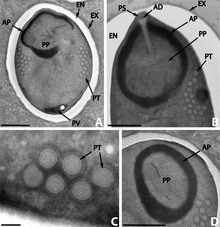Hyperparasite


A hyperparasite is a parasite (or parasitoid) which is parasitic on another parasite. Usually, this means it is parasitic on the larval stage of the victim species.
Typical examples are members of the Apocrita, and some species in two other insect orders, the Diptera (true flies) and Coleoptera (beetles). Seventeen families in the Hymenoptera and a few species of Diptera and Coleoptera are hyperparasitic.[2]
Primary parasitism in the Hymenoptera evolved in the Jurassic period about 135 million years ago.[2]
In literature[change | change source]
Jonathan Swift refers to hyperparasitism in these lines from his poem
"On Poetry: A Rhapsody":[3]
So nat'ralists observe, a flea
Hath smaller fleas that on him prey;
And these have smaller fleas to bite 'em.
And so proceeds ad infinitum.
Number of levels[change | change source]
Three levels of parasitism have been seen in fungi (a fungus on a fungus on a fungus on a tree).[4]
References[change | change source]
- ↑ Toguebaye, Bhen Sikina; Quilichini, Yann; Diagne, Papa Mbagnick; Marchand, Bernard (2014). "Ultrastructure and development of Nosema podocotyloidis n. sp. (Microsporidia), a hyperparasite of Podocotyloides magnatestis (Trematoda), a parasite of Parapristipoma octolineatum (Teleostei)". Parasite. 21: 44. doi:10.1051/parasite/2014044. PMC 4150386. PMID 25174849.
- ↑ 2.0 2.1 Sullivan, Daniel J. (2009). "Hyperparasitism". Encyclopedia of Insects. pp. 486–488. doi:10.1016/B978-0-12-374144-8.00138-7. ISBN 9780123741448.
- ↑ Swift, Jonathan (1733). On Poetry: A Rapsody. And sold by J. Huggonson, next to Kent's Coffee-house, near Serjeant's-inn, in Chancery-lane; [and] at the bookseller's and pamphletshops. Retrieved 20 May 2013.
- ↑ "Fungi Cubed" (PDF).
